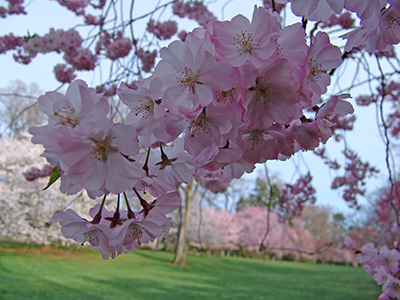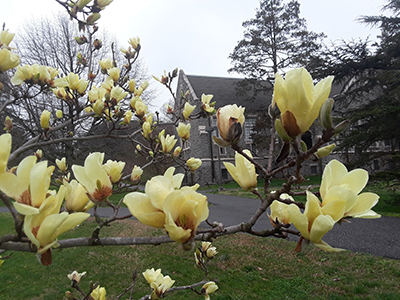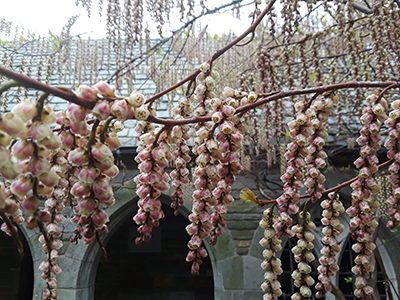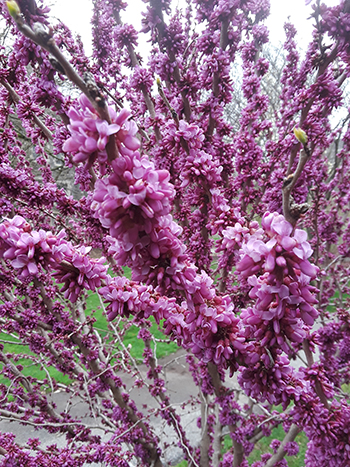
Plant of the Week: April 6

With spring now upon us, a multitude of magnolias and cherries have burst into bloom throughout the Scott Arboretum. This has created a grand composition of pinks, purples, and whites. Splashes of yellow provided by daffodils, forsythia, and other woody plants provide a lovely contrast to this color palette.

One notable yellow flowered plant, which has struck my fancy, is Magnolia ‘Golden Pond’. While a relatively unknown entity to the layperson, yellow magnolias are increasingly popular among discerning gardeners because of their cheerful blooms and pleasant lemony aroma. These marvelous trees are hybrids of Asian magnolias and our native cucumbertree, M. acuminata, from which they receive the desirable yellow flower pigmentation. Among the yellow magnolias in cultivation, shades range from soft pale yellow to a deep buttery coloration, sometimes accompanied by tinges of peach and green.
The lemon yellow flowers of M. ‘Golden Pond’ are among my favorite yellow magnolias and provide quite a pop in the landscape. Tulip-shaped blooms of M. ‘Golden Pond’ appears in late March into early April, with vibrant coloration. Inside the showy corolla of the flower is the unique Magnolia reproductive structure – an attractive and fascinating collection of stamens and stigmas surrounding the large ovary of the developing fruit.
Fruits of yellow magnolias are typically sterile; the large red, cone-like fruits appear infrequently, but when present are an exciting treat for the eye. The large leaves of M. ‘Golden Pond’ are obovate with an entire margin. The bright green new leaves appear with the flowers of M. ‘Golden Pond’, adding to the vibrant springtime effect of this tree. This vigorous hybrid selection between M. acuminata and M. denudata is a fast grower, maturing to a size of approximately 25 tall and nearly as wide.
M. ‘Golden Pond’ makes an excellent specimen tree and is best sited in a sunny location with moist, well drained soil. The showy flowers of M. ‘Golden Pond’ can be found brightening the lawn on the West side of Old Tarble. photo credit: R. Payne-Meyer

Also offering attractive yellow spring blooms is the highly unique Stachyurus praecox. This rare Japanese plant is loved in the horticultural world for its distinctive spring flowers which emerge before foliage in March. The pale yellow flowers of S. praecox are pendant, bell-shaped, and clustered on hanging racemes like beaded chains.
Long arching branches of S. praecox gain a graceful air with the accompaniment of abundant yellow racemes. S. praecox has a broad, rounded form and an informal look. It is a good choice in a mixed shrub border or woodland setting, where the rangy form can be softened when not in flower. S. praecox is also well utilized near buildings and doorways, where the pendant flower racemes are complementary to vertical structures. S. praecox reaches a mature size of approximately 8 feet tall and wide.
This shrub enjoys moist, well drained soils and part-shade. Foliage is ovate, lustrous dark green and lightly serrated. The choice cultivar S. praecox ‘Rubriflora’ boasts red buds, which open light pink, fading to the more typical yellow coloration. You can find a number of Stachyurus specimens throughout the Arboretum, including a handful in the Terry Shane Teaching Garden and Scott Entrance Garden. An ideal specimen of S. praecox ‘Rubriflora’ can be found in the Theresa Lang Garden of Fragrance. photo credit: R. Payne-Meyer

Another plant which has caught my eye on numerous occasions is a stunning Chinese redbud, Cercis chinensis ‘Kay’s Early Hope’. In a time when many are hopeful for better days, this lovely tree is doing its part to brighten things up at the Arboretum. Lavender flowers of C. chinensis ‘Kay’s Early Hope’ adorn this small tree with astonishing abundance in late March. The profusion of blooms cover almost the entire plant from trunk to tips. C. chinensis ‘Kay’s Early Hope’ is one of the earliest redbud cultivars to flower and with the longest bloom duration, flowering from late March to late April, well after leaves have emerged.
This tree is the Asian counterpart of the better known Eastern redbud, Cercis canadensis. The eastern redbud is a North American native used widely throughout local residential landscapes and botanical collections. C. chinensis is typically more shrub-like than C. canadensis, with plants often multi-stemmed or low branching, and blooming before C. canadensis.
This cultivar usually forms a beautiful 15 foot tall and wide vase shape, often with numerous stems. Plants may also be single-stemmed, such as the specimen at the Arboretum located near the entrance of the Worth Health Center in the Magnolia Collection. The characteristic heart-shaped leaves of Cercis are widely adored and provide additional ornamental value throughout the growing season. Each year, the early and reliable blooms of this tree provide a welcome reminder that winter has passed and brighter days are ahead. I hope this tree and the exceptional beauty abounding throughout the Scott Arboretum can provide us all with new hope and vigor as we continue into uncertain times. photo credit: R. Payne-Meyer





No Comments